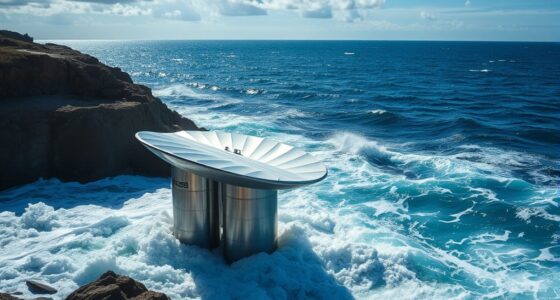Molten-salt brick batteries store solar heat overnight by heating high-temperature molten salts inside refractory brick structures, which act as both the electrolyte and heat reservoir. When sunlight is abundant, the system heats the salts, and during the night, the stored thermal energy is released to generate electricity. These batteries are durable, cost-effective, and support renewable energy integration. Exploring further reveals how innovations improve efficiency and address current challenges in this promising technology.
Key Takeaways
- Molten-salt brick batteries store solar heat by using high-temperature salts as electrolyte, enabling overnight energy release.
- They utilize refractory bricks and materials with high thermal conductivity to retain heat efficiently.
- These batteries support large-scale, renewable energy integration by providing stable, long-duration heat storage.
- Material durability and corrosion resistance are critical for long-term operation at high temperatures.
- Ongoing innovations aim to reduce costs, improve scalability, and enhance heat retention for reliable overnight energy supply.
How Molten-Salt Brick Batteries Work

Molten-salt brick batteries operate by storing electrical energy in high-temperature molten salts, which serve as both the electrolyte and the medium for ion transfer. These batteries utilize innovative materials that withstand extreme heat, enabling efficient thermal integration within the system. As the salts heat up, ions move between electrodes, creating a flow of electricity that can be harnessed for power. The design promotes seamless interaction between thermal and electrical components, allowing heat from solar sources to be stored and later converted into electricity. This integration minimizes energy loss and boosts overall efficiency. By combining advanced materials with smart thermal management, molten-salt brick batteries offer a reliable, sustainable solution for storing solar heat overnight, ensuring energy availability even when the sun isn’t shining. Understanding the material properties of the salts and electrodes is crucial for optimizing battery performance and longevity.
Materials and Construction of the System
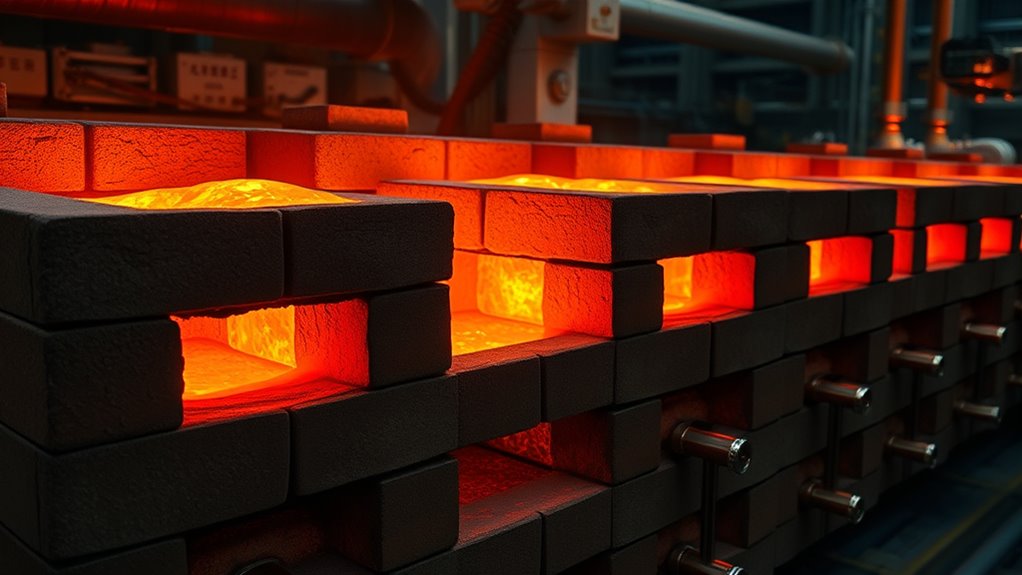
The materials used in molten-salt brick batteries are designed to withstand extreme temperatures and facilitate efficient energy storage. You’ll find that high thermal conductivity materials are essential for effective heat transfer, ensuring the system heats and cools uniformly. The bricks are constructed from refractory substances like alumina or silica, chosen for their ability to handle high temperatures without degrading. Material compatibility is critical; all components must resist chemical reactions with the molten salt to prevent corrosion and maintain system integrity. The construction involves stacking these bricks to create a sealed, thermally insulated chamber that maximizes heat retention. Precise engineering ensures minimal heat loss, making the system reliable for overnight energy storage and efficient solar heat utilization. Additionally, selecting materials with proven high critical temperature ensures durability and safety during operation.
Advantages Over Traditional Energy Storage Methods
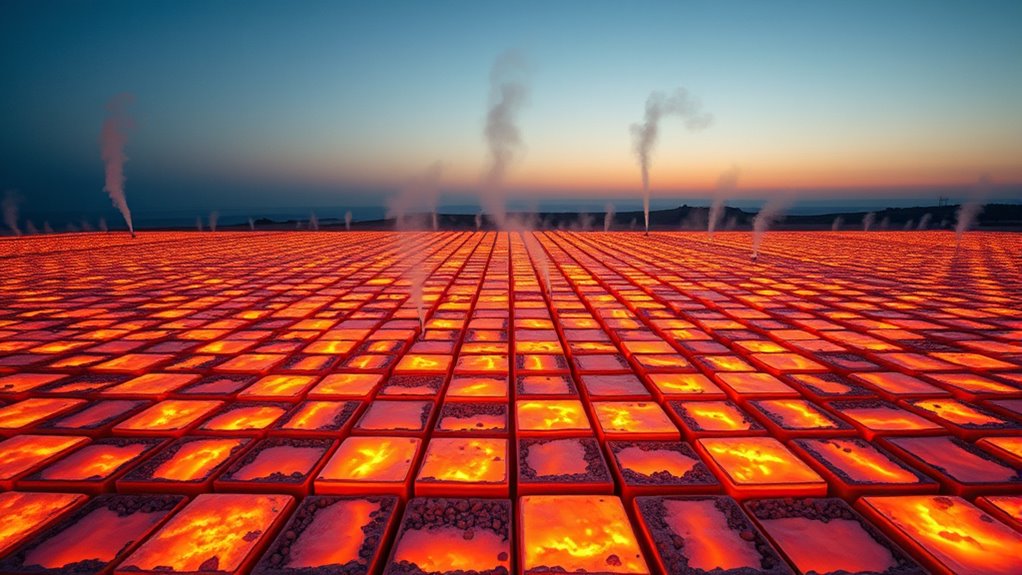
Unlike conventional batteries or chemical storage systems, molten-salt brick batteries offer significant advantages in large-scale energy storage. They provide better economic feasibility by reducing long-term costs and minimizing maintenance needs. These systems also have a lower environmental impact, as they use abundant, non-toxic materials and produce fewer hazardous waste byproducts. Additionally, molten-salt batteries are highly scalable, making them ideal for community or grid-level storage. Their durability means fewer replacements over time, saving resources. Plus, their ability to store heat efficiently enables consistent energy delivery, supporting renewable integration and reducing reliance on fossil fuels. Employing thermal energy storage methods like this greatly enhances energy efficiency and stability. You’ll benefit from a cleaner, more reliable energy future with these innovative storage solutions that are both cost-effective and environmentally responsible.
Efficiency and Heat Retention Capabilities
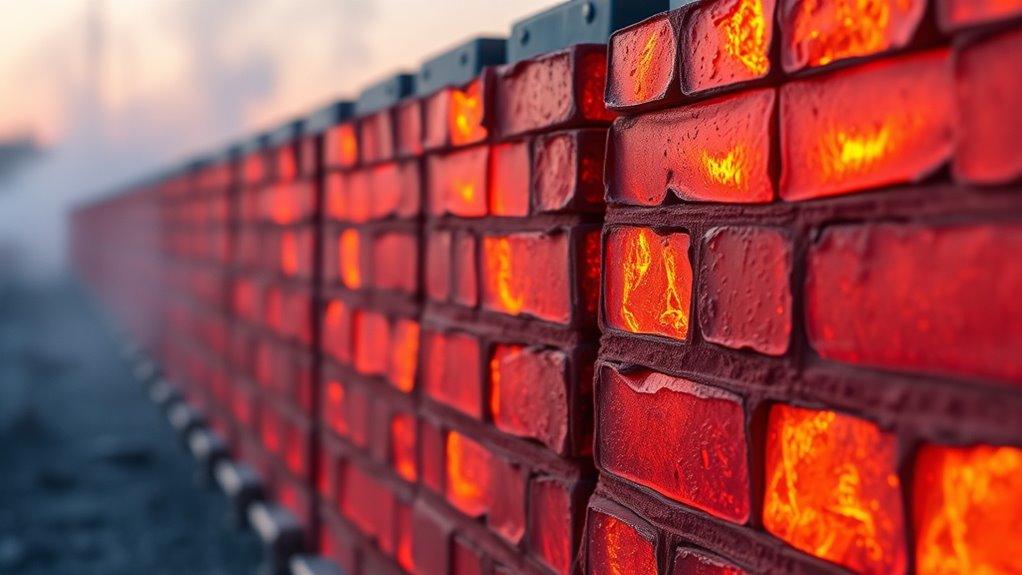
Your molten-salt brick batteries use high-temperature insulation to keep heat from escaping, improving efficiency. With low heat loss rates, more energy stays within the system, reducing waste. This focus on heat retention helps maximize performance and extend the battery’s operational lifespan. Additionally, advancements in automation technologies are facilitating more efficient energy management and system monitoring.
High Temperature Insulation
High temperature insulation plays a crucial role in enhancing the efficiency and heat retention of molten-salt brick batteries. Effective thermal insulation ensures that heat stays trapped within the system, reducing energy loss and maximizing stored heat overnight. When you prioritize high-quality insulation materials, you improve the battery’s ability to retain heat, leading to better performance during cloudy days or nighttime. This not only boosts efficiency but also provides peace of mind knowing your solar energy is stored reliably. Proper insulation creates a stable environment, preventing temperature swings that could damage components. With superior heat retention, your system becomes more resilient and cost-effective, making every joule of stored energy count.
- Feel confident in your energy independence
- Experience reliable power day and night
- Enjoy peace of mind in every season
- Maximize your solar investment
- Trust in your system’s resilience
Low Heat Loss Rates
Low heat loss rates are essential for maximizing the efficiency of molten-salt brick batteries. To maintain high thermocline stability, you need effective insulation that minimizes heat conduction from the hot core to cooler surroundings. When heat escapes easily, it reduces the battery’s ability to store thermal energy overnight. Controlling heat conduction ensures that the stored heat remains concentrated, improving overall heat retention. This stability allows the molten salt to stay at ideal temperatures longer, boosting energy efficiency. Additionally, low heat loss rates help prevent temperature fluctuations that could compromise the battery’s structural integrity or performance. By designing with materials that limit heat transfer, you ensure that your molten-salt brick battery retains heat more effectively, making it a reliable and efficient solution for overnight solar heat storage. Proper insulation techniques are crucial for maintaining thermal energy and ensuring consistent performance over time.
Challenges and Limitations

You’ll face hurdles like material durability issues and the need for materials that can withstand extremely high temperatures. The batteries’ operating conditions make long-term stability a concern, and scaling up production could drive costs higher. Addressing these challenges is vital for making molten-salt brick batteries practical and affordable. Moreover, developing creative solutions to optimize the design and materials can help overcome these technical limitations and accelerate adoption.
Material Durability Concerns
Despite their promising potential, molten-salt brick batteries face significant challenges related to material durability. You need materials with exceptional corrosion resistance to withstand high temperatures and reactive salts. Without this, the brick’s integrity and performance suffer over time, threatening long-term material longevity. The harsh environment can cause cracks, degradation, or failure, risking costly replacements and reduced efficiency. Ensuring the durability of these bricks is essential for reliable energy storage. Your goal is to develop materials that resist corrosion, maintain strength, and last through repeated thermal cycles. If neglected, durability issues could undermine the entire system, leading to costly downtime and safety risks. Pay close attention to developing robust, heat-resistant materials that can endure the demanding conditions of molten-salt storage. Additionally, ongoing AI safety research highlights the importance of monitoring complex systems to prevent unforeseen failures and extend material lifespan.
High Operating Temperatures
Operating at high temperatures presents a significant challenge for molten-salt brick batteries, as materials must withstand extreme thermal conditions without degrading. Thermal expansion becomes a critical concern, as uneven expansion can cause cracks or structural failure. You need materials with low thermal expansion coefficients to maintain integrity over repeated heating and cooling cycles. Additionally, corrosion resistance is crucial because the molten salts are highly reactive, which can corrode container materials and reduce lifespan. Selecting durable materials that resist corrosion ensures the battery remains reliable and safe. Managing heat effectively and choosing the right materials are essential to prevent structural damage and maintain performance. High operating temperatures push the limits of material science but are necessary for the efficient energy storage these batteries provide. Furthermore, ongoing research into high-temperature materials aims to develop more resilient components capable of withstanding these extreme conditions over extended periods.
Cost and Scalability
One of the main hurdles for molten-salt brick batteries is their high production cost and limited scalability. Conducting a thorough cost analysis reveals significant expenses in materials and manufacturing, making widespread adoption challenging. Scalability challenges hinder their ability to meet growing energy demands, especially for large-scale applications.
- You face hurdles in reducing costs without sacrificing performance.
- Limited manufacturing capacity slows down deployment.
- High temperatures demand specialized materials, raising expenses.
- Expanding systems requires overcoming technical and financial barriers.
- Without scalable solutions, your potential to replace traditional storage remains limited.
These obstacles emphasize the need for innovation to lower costs and improve manufacturing capacity, ensuring molten-salt brick batteries can become a viable, large-scale energy storage solution in the future.
Current Applications and Pilot Projects
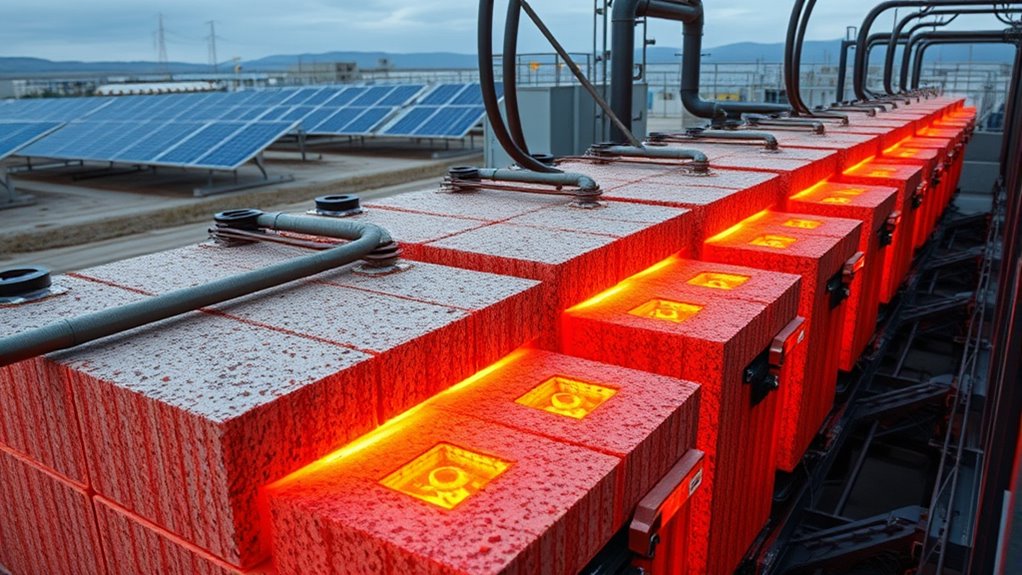
Molten-salt brick batteries are currently being tested in various pilot projects around the world, demonstrating their potential for large-scale energy storage. In urban settings, these batteries are integrated into smart grids to enhance resilience and reduce reliance on fossil fuels. Pilot projects in Europe and Asia showcase their ability to store excess solar heat overnight, supporting clean energy goals. As you observe these initiatives, you’ll notice that urban integration requires careful planning, including infrastructure updates and safety measures. Policy implications also come into play, as governments need to establish regulations that encourage adoption while ensuring safety and environmental standards. These projects serve as proof of concept, paving the way for broader deployment and informing future policies for sustainable energy storage solutions. Understanding the importance of safety measures is crucial for successful integration of these systems into urban environments.
Future Developments in Molten-Salt Brick Technology
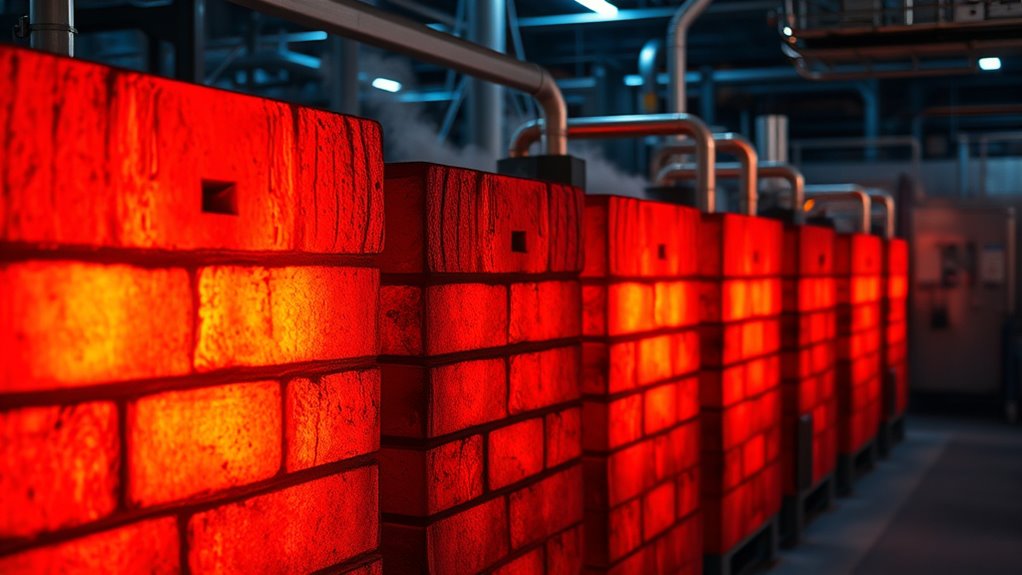
Advances in materials science and engineering are driving rapid innovation in molten-salt brick technology, promising more efficient and durable energy storage solutions. These improvements will enhance renewable integration and bolster grid stability, making solar power more reliable. Future developments may include higher-temperature bricks, improved thermal conductivity, and longer lifespan components, all aimed at maximizing energy retention and discharge efficiency. You’ll see smarter designs that adapt to fluctuating energy demands, ensuring consistent power supply. New composite materials could reduce costs while increasing robustness against thermal stress. These innovations will help integrate more renewable sources into the grid seamlessly, reducing dependency on fossil fuels. As a result, molten-salt brick batteries will become an essential part of a resilient, sustainable energy infrastructure.
- Revolutionize renewable energy storage
- Strengthen grid stability during peak loads
- Lower costs through advanced materials
- Enable seamless renewable integration
- Promote a cleaner, sustainable future
Impact on Renewable Energy Adoption
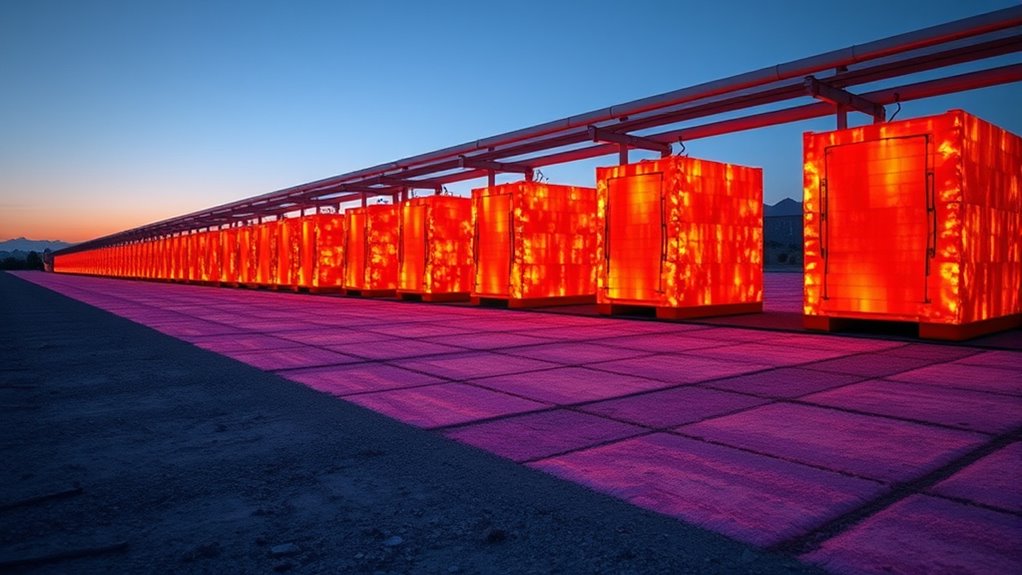
Innovations in molten-salt brick technology are making renewable energy sources more practical and accessible. This advancement reduces environmental impact by providing efficient heat storage, enabling consistent power supply. As a result, renewable adoption accelerates, helping cut greenhouse gas emissions. Policy implications are significant, as governments may encourage or subsidize such tech to meet climate goals. The table below highlights key benefits:
| Benefit | Effect | Stakeholders |
|---|---|---|
| Increased Reliability | Stable energy output | Consumers, utilities |
| Lower Environmental Impact | Reduced emissions | Governments, envs. |
| Enhanced Adoption | Faster renewable integration | Industry, policymakers |
These factors make molten-salt brick batteries a game-changer for renewable energy’s future.
Frequently Asked Questions
What Is the Typical Lifespan of a Molten-Salt Brick Battery?
The typical lifespan of a molten-salt brick battery varies, but you can expect around 20 to 30 years with proper maintenance. Battery degradation happens over time, affecting efficiency, but regular upkeep helps mitigate this. Maintenance challenges include managing corrosion and ensuring the integrity of the bricks. If you stay on top of these issues, you’ll maximize your battery’s longevity and reliability, making it a worthwhile investment for your energy storage needs.
How Cost-Effective Are These Batteries Compared to Other Storage Options?
Imagine weighing the scales of energy storage options; molten-salt brick batteries often tip the balance due to their impressive longevity and thermal stability. You find that their cost comparison favors high initial investments but pays off over time through low operational costs and efficiency. This makes them economically viable for large-scale, long-term storage, especially when compared to batteries with shorter lifespans or higher maintenance needs, ensuring you get more value for your investment.
Are There Environmental Concerns Related to Molten-Salt Brick Disposal?
You might wonder about environmental impact and disposal challenges of molten-salt brick batteries. These batteries contain materials that can pose risks if not properly disposed of, potentially leading to environmental contamination. You should be aware that specialized disposal methods are necessary to manage these challenges safely. Proper recycling and handling are essential to minimize environmental harm, ensuring that the benefits of energy storage don’t come at the expense of environmental health.
Can These Batteries Be Scaled for Large-Scale Industrial Use?
This technology could revolutionize energy storage, but scaling challenges remain. You’ll need to address issues like large-scale industrial integration, ensuring the system’s durability and safety at higher capacities. While potential exists for massive impact, the complexity of expanding molten-salt brick batteries means significant engineering efforts are essential. With meticulous planning, you can overcome these hurdles, paving the way for cleaner, more efficient energy solutions on an industrial scale.
How Safe Are Molten-Salt Brick Batteries During Operation and Maintenance?
You’re concerned about the safety of molten-salt brick batteries during operation and maintenance. These batteries are generally safe because they have high chemical stability, reducing the risk of leaks or reactions. Their design emphasizes thermal containment, which keeps heat controlled and prevents accidents. However, proper handling and maintenance are vital to guarantee safety, as high temperatures and molten salts can pose hazards if not managed correctly.
Conclusion
By harnessing molten-salt brick batteries, you unseal a revolutionary way to store solar heat overnight, turning sunlight into endless energy. This breakthrough surpasses traditional methods, offering unmatched efficiency and durability. As technology advances, you’ll see these systems transform the renewable landscape, making clean energy as reliable as the rising sun. Embrace this innovation, because it’s not just a step forward—it’s a giant leap toward a sustainable future that will redefine energy forever.






